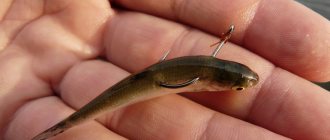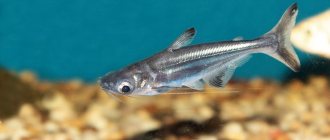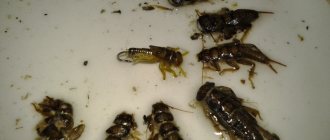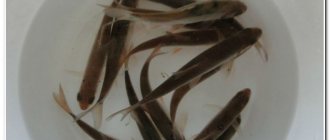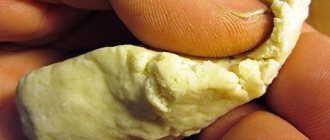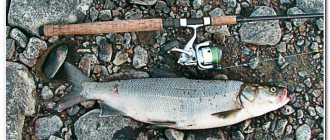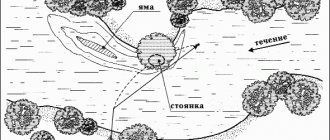Preparing the spinning rod and reel for storage
When the fishing season ends, many anglers do not attach due importance to storing fishing equipment, but in vain. To finish one season and be ready for the next, you need to properly prepare all the details of your fishing equipment:
- All parts of the spinning rod must be inspected, cleaned and dried.
- The fishing line must not be stored under tension. Swivels, snap hooks and weights must be removed and dried.
- Visually inspect the spinning rod. There should be no defects on it, and if they are found, they must be eliminated.
- The spinning reel needs to be disassembled, sand or traces of dirt removed, and old grease removed. Lubricate again.
Zip bags for storing rubber baits and hooks
I use reusable ones, clear ones, in a variety of sizes. They are useful for storing soft plastic baits and various equipment.
We recommend: Minimum fish sizes allowed for catching for the Western Fisheries Basin, save to bookmarks
For example, I put all of my soft rubber lures in the same size bags and then put the whole lot in a large resealable bag.
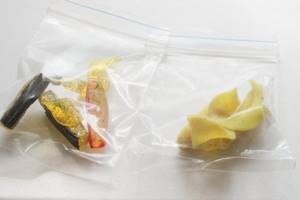
This storage system makes it easy to sort through baits and take them with you, leaving the fishing box in the camp or car, so as not to drag too much, which you have to do if they are in the original packaging.
Storage of spinning rods
The main rule for successfully storing a spinning rod is above-zero temperature, but not near heating devices. Humidity must also meet acceptable standards. In summer it is 30-60%, in cold weather 30-45%.
At home
It’s great when a fisherman has the opportunity to allocate a separate room in his apartment/house for storing spinning rods. If this is not possible, then a closet or pantry will do.
Tubes or special cases (one-, two-, three-section) will be excellent storage options in the apartment. They have a number of advantages:
- protect from mechanical damage;
- compactly accommodate all gear and do not take up much space;
- they can be placed on a shelf, in a closet and even under the bed;
- one place to store all components.
About
Long-term storage
In order to preserve live bait for winter fishing at home longer, you need to pay more attention to this process. Of course, you won’t need the same amount of care and attention as for delicate aquarium fish. However, some patience and care will have to be shown. Let's look at how to keep and store live bait at home for a long time, up to several months. Here are the important nuances of home storage:
- Different types of fish should be kept separately, especially ruffs (the mucus they secrete destroys other fish).
- The easiest way to preserve crucian carp is that they are the most tenacious. Then - roach, the most sought after live bait. It is a little more difficult to care for perch and ruffe (you need to even more carefully monitor the purity of the water, aerate it and change it on time. The most difficult ones to care for are bleak, spined gudgeon, loach, and silver bream. They need to be kept in a large volume of clean water with a constant temperature and increased aeration Therefore, the main objects of long-term keeping are crucian carp, roach, perch and pipe cleaners.
- The main thing during the entire storage process is a constant low water temperature. In summer, even crucian carp cannot be preserved in warm water for a long time (with the exception of cages in the river). In winter, at temperatures close to zero, even small roach and perch will feel great.
- The larger the live bait, the more difficult it is to preserve it.
- An important condition is a sufficient volume of water.
- The water needs to be changed and aerated periodically (manually or with a compressor).
- During long-term storage, fry need to be fed occasionally.
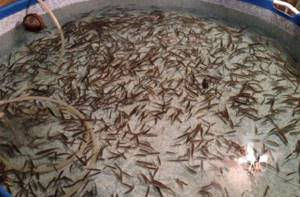
Tara
The storage container needs to be spacious and wide. The width of the water surface must be at least twice the depth for normal natural aeration. Better is more. The ideal option is a wide plastic basin. The volume depends on the amount of fish stored. The minimum ratio is that the volume of water should exceed the weight of the live bait by 8 times. If the storage period is more than 2 weeks, then the proportion should be at least 1 to 100. Thus, in an ordinary plastic basin you can easily contain several dozen live bait.
The best option is an inflatable plastic pool with an aerator. However, you cannot install it in an ordinary city apartment. The simplest solution is a plastic bucket (for a dozen fish). 30-50 live bait can be kept in a wide basin. Even more - in the bathroom (if the wife doesn’t mind giving it away for a couple of months). Crucian carp can be planted more densely, roach and perch - less often. The greater the density of the fish, the more often you need to change the water and forcefully aerate the container.

Temperature
The most important condition for keeping the fry alive for winter fishing for a long time is the ambient temperature. It should not exceed 4-5 degrees Celsius. Or better yet, 2-3 degrees. This can be achieved by placing the container on the balcony or in a vestibule, unheated hallway, etc. You can keep it almost outside in a slight frost - in this case you need to make sure that the basin does not freeze, and also remove the ice for normal aeration. If you managed to achieve a constant temperature for a long time, then the baitfish will live for the entire period; all that remains is to change the water and aerate the reservoir. It is best to install a thermometer in the container so that you can constantly monitor this important indicator.
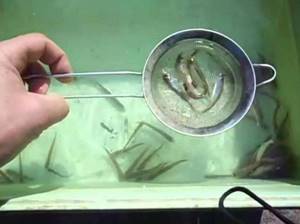
Changing water
To preserve live bait at home for a long time, the water in the container must be changed periodically. The lower the ratio of the volume of water and the fish found, the more often. For long-term storage, this procedure is put on stream. Water for replacement has already settled nearby in advance. The water settles for at least three days. At the time of replacement, the new liquid should be at the same temperature as in the container with fish. Changing water is a constant and gradual task. You cannot change the entire volume at once - it is better to change a quarter, for example, every day. It’s a good idea to add fresh, clean snow to the container. The first replacement is done after 2-3 days, when the live bait’s intestines are cleansed, and then constantly periodically. With a large volume of water and a small amount of live bait, you can change the water less often, and for crucian carp - once every 10 days. The main thing is to do this gradually so that the fish does not experience shock, and without temperature jumps.
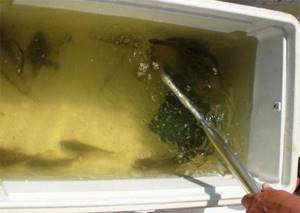
Oxygen
To preserve live bait for fishing at home in winter, the fish must not be starved of oxygen. To do this, the container with live bait needs to be additionally aerated. You can do this manually, scooping up water with a mug every day and pouring it back from a height. An interesting solution is a manual aerator made from a ball, a pump, a sprayer and an old air divider for an aquarium. Another way is from a bucket with holes in the bottom suspended above the container. The bucket is filled from the fish pool, then the water flows back. Manual methods are suitable for crucian carp and roach in large volumes of water and with frequent water changes. The best solution is a constantly running aquarium aerator.
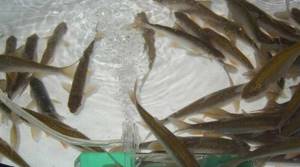
Transfer to a canal for fishing from the main storage
It is better not to climb with your hands in the main tank, so as not to thermally injure the fry and not cause an infection. You need to use a small net. Under no circumstances should you pick up live bait with warm bare hands - it will suffer a temperature shock or even a burn, and the fish will quickly die. Live bait is caught with a net and placed in a fishing can (bucket) with the same water from the storage. Then clean, settled water of the same temperature is added to the main storage to the original volume.
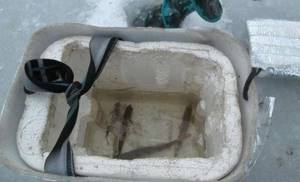
Subscribe to the channel:
My YouTube channel RYBAFAN on fishing:
We're OK
Spinning reel storage
The storage conditions for spinning reels are almost identical to the storage conditions for spinning rods:
- the coil must be disassembled and inspected;
- clean from sand and dirt, remove old grease;
- re-lubricate the coil and place it in a fabric bag;
- Coils should be stored in a heated room with an acceptable level of humidity and without temperature changes.
Caring for your rod after fishing
At the end of each fishing, the rod should be cleaned of dirt and sand. Particular attention should be paid to the joints of the knees. One of the main enemies is sand, which abrades the surface at the joints of both plug-type and telescopic knees.
Wipe the entire form with a damp cloth soaked in soapy water. At the same time, we try to prevent water from getting inside. Let the rod dry before disassembling.
The rod guides (if you don’t have a flywheel or a plug) can be cleaned with a small brush, such as a toothbrush. And the inner surface of the rings and the reel seat - with a cotton swab moistened with alcohol.
How to store spinning leashes
Despite its simplicity, a leash is considered a very important part of a fisherman’s equipment. There should be a lot of leashes. But the question arises about their storage and convenient organization. For this purpose:
- Leash holders - with one compartment, or folding ones with two. Special systems for storing leashes, which differ in shape, material (available from plastic, wood) and size. They have a rigid body and a durable lid that protects the contents from damage.
- Plastic reels. Depending on the type, up to four leashes can be placed on one reel.
- Photo album with pockets. Instead of photographs, leashes are placed in pockets and the size and diameter are labeled.
- Other homemade options made from plastic or metal pipes of small diameter, empty containers made from construction silicone, etc.
About
How to store fishing gear
Each fisherman has his own personal inventory of gear, which is periodically replenished. To prevent them from deteriorating or breaking, you need to store them in their places.
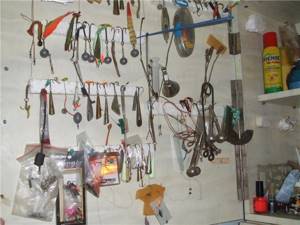
The room where the fishing rods are kept should be dry and warm. The best option is to buy a case that has many compartments so that each fishing rod is separate from each other.
Before fishing, you need to inspect your fishing rods. You need to wipe off dust and dirt with a cloth to make sure there is no damage. The fishing rods themselves often have small scratches. This can be avoided if you shake off the sand from your fishing rod after each fishing trip. If you take care of it like this, it will last a long time. If the damage is deep, then it is better to send the fishing rod for repairs.
Reels require special care. When fishing, place the fishing rod on a stand so that the reel does not get wet. Because water can cause it to rust and break.
After fishing, you need to wipe the reel and all its components with a dry cloth. Store the reel in a tube on a shelf. There is no need to disassemble and reassemble the coil every time, as this will break it.
Read: About bite alarms: what they are and how to make them
For small items, it is best to purchase a box that has many different compartments. You can put there: hooks, fishing line, sinkers, carabiners, floats. Spinning baits are stored in drawers with drawers. It’s convenient because baits can be sorted by type, size, and weight.
All these boxes and boxes are stored in the closet. You can also sign them so that you know what is where.
When fishing, you always take bait for fish, which you can make yourself or buy in a store. But it is advisable to use the entire opened pack of complementary foods when fishing. If the bait remains after fishing, it is poured into one dry box.
Bulk complementary foods are stored in a dry place. They cannot be stored on the balcony or in the garage, as there are changes in temperature and humidity. If there is any complementary food left after fishing, it is better to store it in the freezer. Live baits are also stored in the refrigerator. For example, blowfly larvae can be stored in the refrigerator. There it can stay for up to a month. It is better to store liquid additives on the balcony in plastic bottles that are closed with lids.
Read: How to make a nod for winter fishing
Fishing bags can be stored in the pantry, on the balcony and in the garage, as long as they do not contain items that should not be exposed to temperature changes. Periodically you need to check to see if water has gotten inside. It is also necessary to sew up covers, backpacks, and repair zippers.
After fishing, cages must be ventilated or washed. Nowadays, fishermen use sports cages. They are long and have many compartments. I use mesh as a material. After fishing, such cages need to be washed and dried.
It is best to wash cages that are made of fabric separately from other items. Because the smell of fish is transferred to other things.
If you store your fishing gear carefully, it will last a long time. This will allow you to save money on purchasing new hobby equipment.
